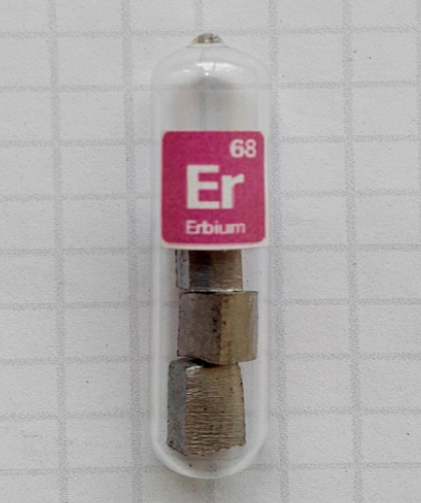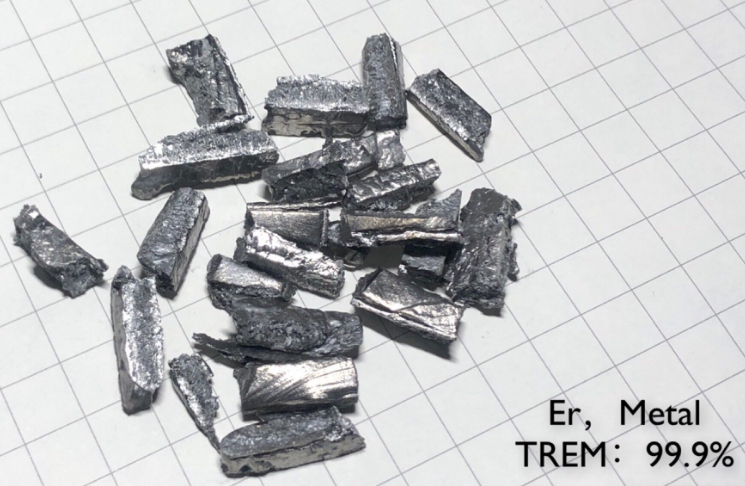Erbium metal
Erbium is a silver-white metal; melting point is 1529°C, boiling
point is 2863°C, density is 9.006g/cm3; Erbium is antiferromagnetic at
low temperatures, strong ferromagnetism near absolute zero, and a
superconductor.
Erbium is slowly oxidized by air and water at room temperature, and
erbium oxide is rose red.
Erbium can be used as a reactor control material; Erbium can also be
used as an activator for some fluorescent materials. The first
ionization energy is 6.10 electron volts. The chemical and physical
properties of holmium and dysprosium are almost identical.
Application areaedit
The oxide Er2O3 is rose red, which is used to make pottery glaze. Erbium
oxide is used in the ceramic industry to produce a pink enamel. Erbium
also has some applications in the nuclear industry and can also be used
as an alloy component of other metals. For example, adding erbium to
vanadium can enhance its ductility.
The most prominent use of erbium is to manufacture Erbium Dopant Fiber
Amplifier (EDFA). Erbium-doped fiber amplifier (EDFA) was first
developed by the University of Southampton in 1985. It is one of the
greatest inventions in optical fiber communication, and it can even be
said to be the "gas station" of today's long-distance information
highway. Erbium-doped fiber is a silica fiber doped with a small amount
of rare earth element erbium ions (Er3+), which is the core of the
amplifier. The principle of erbium-doped fiber amplifying optical
signals is: when Er3+ is excited by light with a wavelength of 980nm or
1480nm to absorb the energy of the pump light, it transitions from the
ground state to the high-level pump state. Due to the short lifetime of
the particles in the pumped state, they will quickly relax from the
pumped state to the metastable state in a non-radiative manner. The
particles will have a longer lifetime in this energy and gradually
accumulate. When 1550nm signal light passes through, the metastable Er3+
ion transitions to the ground state in the form of stimulated radiation,
and it also emits light with a wavelength of 1550nm. This light emitted
when jumping from the high-energy state to the ground state supplements
the signal light with attenuation loss, so that the signal light is
continuously amplified with attenuation during the propagation of the
optical fiber.
Doping erbium into ordinary silica fiber, coupled with a semiconductor
laser with two wavelengths of 980 nm or 1480 nm, basically constitutes
an amplifier that directly amplifies the 1550 nm optical signal. Quartz
optical fiber can transmit light of different wavelengths, but the light
attenuation rate is different. The light attenuation rate of 1550nm band
is the lowest (only 0.15 dB/km) when transmitted in the quartz fiber,
and the attenuation rate is almost the lower limit. Therefore, when
optical fiber communication uses light with a wavelength of 1550 nm as
signal light, the light loss is minimal. Therefore, as long as the
optical fiber is doped with tens to hundreds of ppm of erbium, it can
play a role in compensating the optical loss in the communication
system. The erbium-doped fiber amplifier is like an optical "pumping
station", which enables the optical signal to be transmitted from one
station to another without any loss, thus smoothly opening the technical
channel of modern long-distance large-capacity high-speed optical fiber
communication.
Another application hot spot of erbium is laser, especially as a medical
laser material. Erbium laser is a solid-state pulsed laser with a
wavelength of 2940nm, which can be strongly absorbed by water molecules
in human tissues, so that it can achieve greater results with less
energy, and can cut, grind and excise soft tissues very accurately.
Erbium YAG laser is also used for cataract removal. Because the main
component of the cataract lens is water, the erbium laser has low energy
and is easily absorbed by water. It will be a promising surgical method
for cataract removal. Erbium laser treatment instrument is opening up
more and more broad application fields for laser surgery.
Erbium can also be used as an active ion for rare earth up-conversion
laser materials. Erbium laser up-conversion materials are divided into
single crystal (fluoride, oxygen-containing salt) and glass (fiber),
such as erbium-doped yttrium aluminate (YAP: Er3+) crystal and
Er3+-doped ZBLAN fluoride (ZrF4- BaF2-LaF3-AlF3-NaF) glass optical
fiber, etc., have now been put into practical use. BaYF5: Yb3+, Er3+ can
convert infrared into visible light. This multiphoton up-conversion
luminescent material has been successfully used in night vision devices.
.
.
.


Erbium is a silver-white metal; melting point is 1529°C, boiling
point is 2863°C, density is 9.006g/cm3; Erbium is antiferromagnetic at
low temperatures, strong ferromagnetism near absolute zero, and a
superconductor.
Erbium is slowly oxidized by air and water at room temperature, and
erbium oxide is rose red.
Erbium can be used as a reactor control material; Erbium can also be
used as an activator for some fluorescent materials. The first
ionization energy is 6.10 electron volts. The chemical and physical
properties of holmium and dysprosium are almost identical.
Application areaedit
The oxide Er2O3 is rose red, which is used to make pottery glaze. Erbium
oxide is used in the ceramic industry to produce a pink enamel. Erbium
also has some applications in the nuclear industry and can also be used
as an alloy component of other metals. For example, adding erbium to
vanadium can enhance its ductility.
The most prominent use of erbium is to manufacture Erbium Dopant Fiber
Amplifier (EDFA). Erbium-doped fiber amplifier (EDFA) was first
developed by the University of Southampton in 1985. It is one of the
greatest inventions in optical fiber communication, and it can even be
said to be the "gas station" of today's long-distance information
highway. Erbium-doped fiber is a silica fiber doped with a small amount
of rare earth element erbium ions (Er3+), which is the core of the
amplifier. The principle of erbium-doped fiber amplifying optical
signals is: when Er3+ is excited by light with a wavelength of 980nm or
1480nm to absorb the energy of the pump light, it transitions from the
ground state to the high-level pump state. Due to the short lifetime of
the particles in the pumped state, they will quickly relax from the
pumped state to the metastable state in a non-radiative manner. The
particles will have a longer lifetime in this energy and gradually
accumulate. When 1550nm signal light passes through, the metastable Er3+
ion transitions to the ground state in the form of stimulated radiation,
and it also emits light with a wavelength of 1550nm. This light emitted
when jumping from the high-energy state to the ground state supplements
the signal light with attenuation loss, so that the signal light is
continuously amplified with attenuation during the propagation of the
optical fiber.
Doping erbium into ordinary silica fiber, coupled with a semiconductor
laser with two wavelengths of 980 nm or 1480 nm, basically constitutes
an amplifier that directly amplifies the 1550 nm optical signal. Quartz
optical fiber can transmit light of different wavelengths, but the light
attenuation rate is different. The light attenuation rate of 1550nm band
is the lowest (only 0.15 dB/km) when transmitted in the quartz fiber,
and the attenuation rate is almost the lower limit. Therefore, when
optical fiber communication uses light with a wavelength of 1550 nm as
signal light, the light loss is minimal. Therefore, as long as the
optical fiber is doped with tens to hundreds of ppm of erbium, it can
play a role in compensating the optical loss in the communication
system. The erbium-doped fiber amplifier is like an optical "pumping
station", which enables the optical signal to be transmitted from one
station to another without any loss, thus smoothly opening the technical
channel of modern long-distance large-capacity high-speed optical fiber
communication.
Another application hot spot of erbium is laser, especially as a medical
laser material. Erbium laser is a solid-state pulsed laser with a
wavelength of 2940nm, which can be strongly absorbed by water molecules
in human tissues, so that it can achieve greater results with less
energy, and can cut, grind and excise soft tissues very accurately.
Erbium YAG laser is also used for cataract removal. Because the main
component of the cataract lens is water, the erbium laser has low energy
and is easily absorbed by water. It will be a promising surgical method
for cataract removal. Erbium laser treatment instrument is opening up
more and more broad application fields for laser surgery.
Erbium can also be used as an active ion for rare earth up-conversion
laser materials. Erbium laser up-conversion materials are divided into
single crystal (fluoride, oxygen-containing salt) and glass (fiber),
such as erbium-doped yttrium aluminate (YAP: Er3+) crystal and
Er3+-doped ZBLAN fluoride (ZrF4- BaF2-LaF3-AlF3-NaF) glass optical
fiber, etc., have now been put into practical use. BaYF5: Yb3+, Er3+ can
convert infrared into visible light. This multiphoton up-conversion
luminescent material has been successfully used in night vision devices.
.
.
.

|

|
